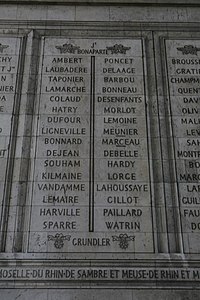Alexandre Camille Taponier
Alexandre Camille Taponier (born February 2, 1749 in Valence , † April 14, 1831 in Vanves ) was a French Général de division during the coalition wars .
biography
Military career
His military career began on November 25, 1767 as a soldier in the Régiment des Gardes françaises . In 1789 Taponier was a sergent of a grenadier regiment involved in the storming of the Bastille prison . Here he was at the forefront of the storming. After this action he was promoted to Sous-Lieutenant in the months that followed . From September 1st of the same year he was employed as aide-major (assistant in the staff) of the National Guard of Paris. In 1791 Taponier was involved in the blockade of the Landau fortress , was promoted to Capitaine on January 1, 1792 and transferred to the "103e régiment d'infanterie de ligne" (103rd Limien Infantry Regiment). With the Armée du Nord he took part in the blockade of Thionville and in the campaign to Trier . At the beginning of 1793 he was promoted to Général de brigade and on November 7 of the same year he was promoted to Général de division. At the same time he was given command of the 8th Division under the command of Laurent de Gouvion Saint-Cyr . On November 20 he took Hornbach , it was followed by the Battle of Kaiserslautern from November 28 to 30, and the Second Battle of Weissenburg from December 26 to 27, 1793. On 25 frimaire an II (December 15, 1793) was he was one of the generals who had taken away the heights of Marschall, Dahnbrück and Lembach. On the 18th of Ventose an III (March 8th, 1794), three Austrian battalions were wiped out and two flags captured under his command. On October 16, 1795, he had to temporarily retire from service due to an injury. He then distinguished himself in the removal of the fortifications from Reichshoffen and in the attack near Trippstadt , where his troops managed to capture eight cannons. He was able to distinguish himself in 1796 in the battle of Rastatt and in the battle near Ettlingen , but was then relieved of his post by order of Général Moreau , as he was accused of having arbitrarily raised war contributions.
On February 13, 1797 he was released and retired to Vanves, but was reactivated on October 2, 1799 and sent to the Armée d'Angleterre (English "invasion" army) in Pontivy , where he was governor of the XIII. Division remained until January 14, 1800. After that he was busy with his troops in the coastal defense.
On March 29, 1801, he was again put up for disposition without ever receiving a command under Napoleon and finally retired on June 10, 1811. In the meantime, on March 29, 1805, he was awarded the "Chevalier de la Légion d'honneur" (Knight of the Legion of Honor ).
Others
The "Rue Campagne-Première" in the 14th arrondissement of Paris got its name from Général Taponier, who owned land in the area and who wanted to commemorate his first campaign (the battle of Weissenburg) in this way.
Taponier's grave is on the Cimetière Montparnasse , one of the three large Parisian cemeteries that were laid out at the beginning of the 19th century outside the city limits. It is looked after by Souvenir français and was restored in 1997.
Honors
His name is entered on the triumphal arch in Paris in the 5th column.
literature
- Charles-Nicolas Beauvais "Victoires, conquêtes, désastres, revers et guerres civiles des Français, de 1792 à 1815" Editeur = CLF Panckoucke 1822
- "Dictionnaire historique des batailles, sièges, et combats de terre qui ont eu lieu pendant la Révolution française" ÉditeurLibr. Menard et Desenne Paris 1818 p. 416
- André Blanc "Valence à travers les hommes" Editions SOREPI Valence 1975
Individual evidence
- ↑ Valentin Streffleur: Streffleur's Austrian military magazine. Issues 10–12, Vienna 1824, p. 248
- ↑ Alexandre Camille Taponier Cimetière du Sud called "du Montparnasse"; 3rd division, right
| personal data | |
|---|---|
| SURNAME | Taponier, Alexandre Camille |
| BRIEF DESCRIPTION | French general |
| DATE OF BIRTH | February 2, 1749 |
| PLACE OF BIRTH | Valence |
| DATE OF DEATH | April 14, 1831 |
| Place of death | Vanves |
